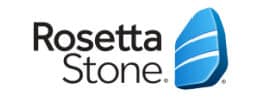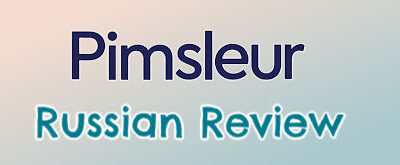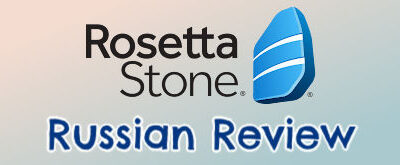Although Rosetta Stone is quite possibly the most popular language learning company in the entire world, that doesn’t necessarily mean it is the right fit for you. In this review, we cover everything you need to know to make a decision as to whether Rosetta Stone is the ideal Italian language app for your needs and budget.

Rosetta Stone
- Multiple Subscription Options
- Money Back Guarantee
Pros
- Reasonably priced subscription plans ($10-$15/mo)
- Great choice for visual learners (image-heavy lessons)
- Immersive learning framework accelerates language acquisition
- Bonus tools and resources (e.g. short stories, phrasebooks)
- Sleek, easy-to-use digital platform and mobile app
Cons
- Lesson format is somewhat repetitive
- Limited grammar instruction
- Speaking exercises are basic
Video: Is Rosetta Stone Italian Worth It?
In the video above, Bianca from the Guide2Fluency team covers the pros and cons of using Rosetta Stone to learn Italian.
How The Rosetta Stone Italian Program Works
From a high level, there are 20 learning units within the Rosetta Stone Italian course that cover all sorts of different thematic topics (e.g. travel, dining, hobbies).
Then within each learning unit, there are typically four lessons that break down further into four sections – you have a core lesson, which takes around 30 minutes to complete, and then different tasks for pronunciation, vocabulary, and grammar, which all take around 10 minutes each.
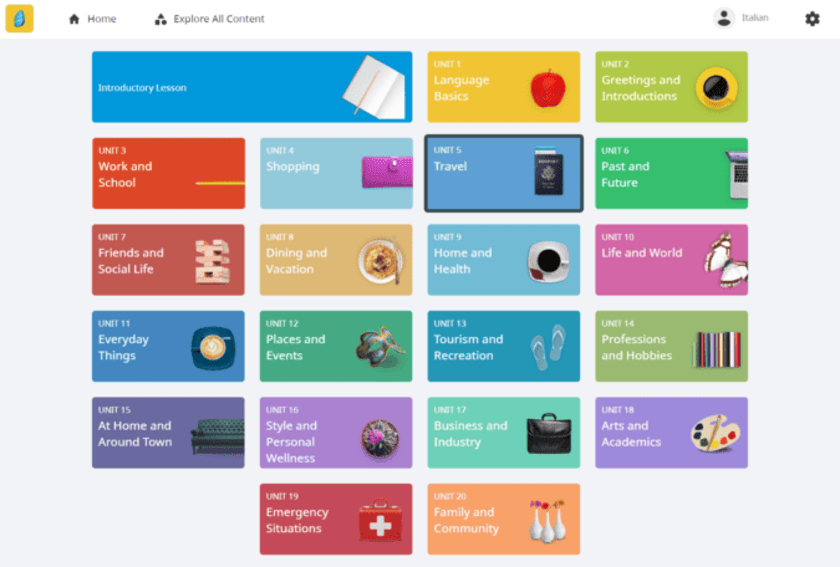
Therefore, all in all, you’re looking at about an hour per lesson from start to finish.
However, keep in mind, that when you first sign-up for Rosetta Stone, you’ll be asked a few questions like what your baseline Italian fluency level is, and why you want to learn Italian, and based on your answers, you’ll have the option to have Rosetta Stone build you a custom weekly study plan to follow instead. In other words, if you don’t want to follow the standard 20 unit learning path, you don’t have to.
The Rosetta Stone Learning Framework
The key point to remember here is that the Rosetta Stone program is grounded in immersion and imagery.
First, unlike other Italian language apps, Rosetta Stone does not use English translations with the idea being that constant exposure to the Italian language will accelerate the learning process.
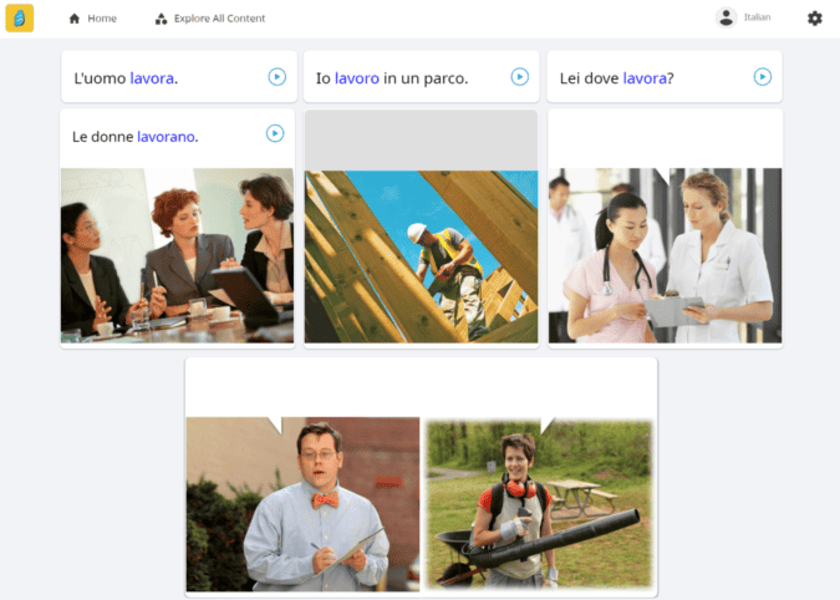
Then second, Rosetta Stone utilizes images and pictures within lessons in order to help learners associate new vocabulary with visual representations, and provide context for words and phrases.
Rosetta Stone Italian Cost
Rosetta Stone offers a few different plans to choose from. There are two different monthly subscription options that range in price from $10 to $15, and then there’s a lifetime plan that costs around $400.
However, it’s worth noting the lifetime plan also includes access to all Rosetta Stone language courses (not just Italian), so keep this mind if you have any desire to learn multiple languages. Plus, you can often find the lifetime plan on sale for less than $200!
All in all, Rosetta Stone lands near the middle of the language learning industry in terms of cost. For example, their subscription plans are slightly more expensive than the likes of Babbel and Memrise, but more wallet-friendly than the likes of Rocket Italian and Pimsleur Italian.
Pros Explained
Now that we’ve covered the Rosetta Stone Italian course structure, learning method, and pricing, let’s move into the pros and cons that our team discovered as we tested this language app.
Visually Appealing Program
As you might imagine given what we said earlier about lesson format, Rosetta Stone is an ideal program for people who identify as visual learners. After all, Rosetta Stone lessons utilize pictures as the foundation of pretty much every practice drill within their course, which is obviously perfect for individuals who tend to use visual imagery to remember information.
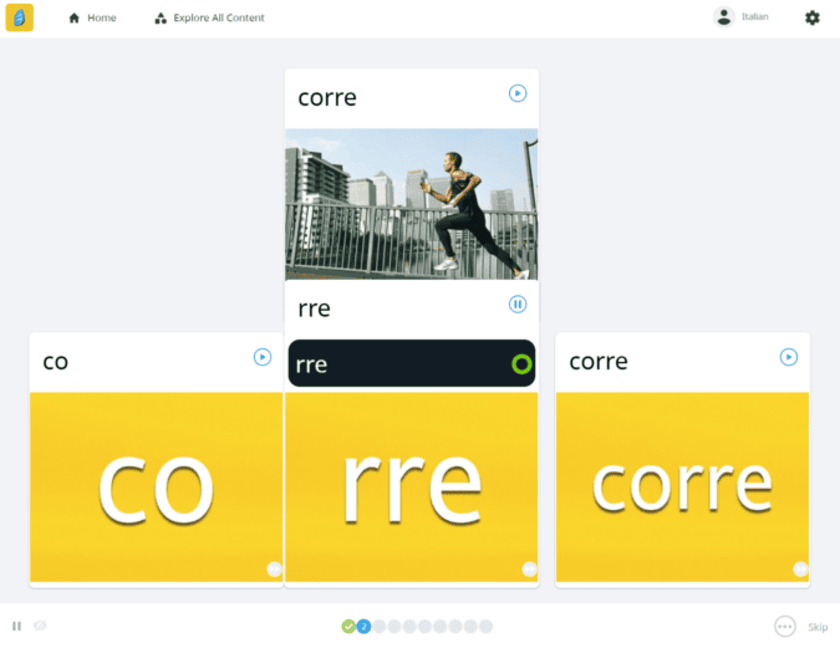
Plus, we should also mention that Rosetta Stone offers supplemental on-demand videos as well, further catering to visual learners.
Overall, the Rosetta Stone Italian program is visually appealing and well-suited for those who prefer a visual approach to language learning.
Italian Immersion
The second advantage of using Rosetta Stone, in my opinion, is their focus on immersive learning.
While we know that an immersive approach to learning can be challenging, especially initially when you lack a baseline understanding of the language, our team believes that in the long run, this approach significantly accelerates the language acquisition process.

Constant exposure to Italian words and phrases leads to rapid and more effective expansion of vocabulary compared to studying in a non-immersive environment, where reliance on translations can hinder fluency development.
This is noteworthy because fluency ultimately involves thinking and expressing oneself directly in the target language, rather than mentally translating between languages, so from this perspective, we like Rosetta Stone’s immersive learning framework.
Speech Recognition Software
It’s evident that Rosetta Stone has dedicated significant resources to ensure their TruAccent speech software is fast, accurate, and user-friendly.
Throughout the Rosetta Stone lessons, you’ll engage in various drills where you listen and then repeat Italian words and phrases, allowing the company’s speech tool to assess and grade your pronunciation.
This is important because not only does crisp, accurate pronunciation help facilitate your understanding of native Italian speakers, but it also enhances your confidence in using the language in social and professional settings.
While pretty much every language learning company on Earth uses some sort of speech recognition tool, Rosetta Stone’s is easily among the best our team has used and tested to date.
Bonus Resources & Live Classes
Rosetta Stone also provides learners with free access to a variety of extra tools and resources to supplement the learning process. These include the on-demand videos we referenced earlier, short stories, phrasebooks, audio companions, and more.
Among these tools, the short stories stand out as a personal favorite of our team. They’re just an easy, refreshing way to take a break from the standard Rosetta Stone lessons, but what’s particularly appealing about the stories feature is the flexibility they offer – learners can choose to listen to a fluent Italian speaker read the story, you can read it silently yourself, or you can record yourself reading and then listen back to assess your pronunciation progress.
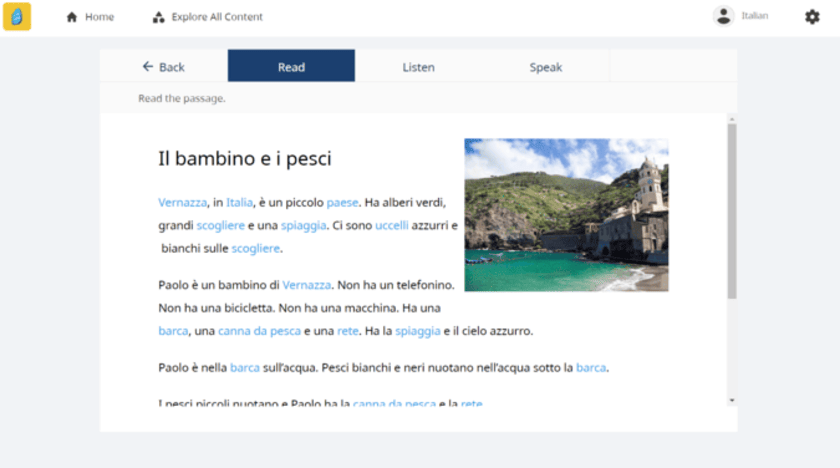
Plus, what’s cool is that these stories cover a wide range of topics and subjects, providing not only a chance for you to practice your vocabulary, but also learn about Italian culture.
Additionally, Rosetta Stone offers live lessons, classes, and tutoring services as well. However, unlike their other resources, these live sessions are not free (i.e. you do have to pay extra), but for learners at an intermediate level of fluency, these live sessions are super valuable since you can interact with other learners at a similar level of fluency and engage in real-world conversations.
Cons Explained
Now that we’ve covered the positives, let’s discuss the negatives next. That way you have an unbiased view of what Rosetta Stone has to offer.
Repetitive Lesson Format
The first drawback of Rosetta Stone is that their lessons can become boring and repetitive at times, since they basically consist of the same four or five drills and exercises repeated throughout.
This is why the bonus resources and tools we mentioned earlier are so crucial. The truth is most people are going to want to switch things up and take a break from the standard lessons pretty regularly.
Therefore, if you tend to get distracted or bored easily, other Italian language programs like Babbel or Pimsleur may be a better fit since their lessons offer more diversity and engagement.
Basic Verbal Practice
The next drawback with Rosetta Stone relates to its speaking exercises, and while we appreciate the quality of the company’s TruAccent speech software, our concern lies more with the exercises themselves. They’re just basic in nature and don’t seem to progress beyond a beginner level given that you’re really just asked to listen and repeat isolated words and phrases.
To put it differently, the speaking exercises lack context, pressure, and recall, which are crucial for learning to use the language in real-world situations. After all, without context, learners will struggle to understand how words and phrases are used in different situations. At the end of the day, we just wish that Rosetta Stone’s speaking drills were more comprehensive, akin to the simulated conversations offered in the Rocket Italian program.
Limited Grammar Instruction
The last negative we want to highlight has to do with grammar. Unlike other language learning companies, Rosetta Stone does not provide any direct grammar instruction.
Instead, the company encourages learners to intuitively pick up grammar through exposure and practice. Rosetta Stone’s aim is for learners to naturally notice and pickup grammar patterns themselves.
Now to be fair, this approach has its supporters and critics. Some linguists and language learning companies advocate for direct instruction, believing that clear explanations of grammar rules and structures help learners understand the underlying framework of the language, making it easier to grasp new concepts and apply them appropriately.
On the other hand, proponents of natural grammar acquisition, like Rosetta Stone, argue that focusing on memorizing rules can hinder the intuitive feel and understanding you develop for the language.
The choice ultimately between these approaches depends on your individual preferences. If you prefer direct and easily digestible grammar instruction, a program like Rocket Italian might be more suitable. However, if you prefer to learn grammar naturally and intuitively, Rosetta Stone could be an excellent choice.
Verdict: Is Rosetta Stone Italian Good?
Well, the easy answer as to whether Rosetta Stone is a suitable choice largely depends on your objectives and preferred learning approach. If you’re more of an auditory learner or you get frustrated easily and prefer learning with readily accessible English translations, then Rosetta Stone Italian may not be the ideal fit since the program is primarily designed around immersive learning, using image-based exercises.
Instead, Rosetta Stone particularly benefits active, visual learners. For our team, this approach was highly effective. We appreciated the interactive drills, the immersive environment that encouraged critical thinking, and the valuable extra resources.
Therefore, the final answer is that while Rosetta Stone may not suit everyone, we believe it can be very effective for most individuals aiming to achieve an intermediate level of Italian fluency.
Rosetta Stone offers multiple different subscription options ranging from $10 to $15 per month. Alternatively, you can purchase a lifetime Rosetta Stone subscription for around $400 (although you can often find it on sale for much less).
Assuming you spend around 10 hours per week learning Italian, you can likely achieve a basic to intermediate level of fluency within 15 to 25 weeks.
In order to complete the standard Rosetta Stone Italian lessons, it will require around 80 hours of time. However, once you factor in the additional resources that Rosetta Stone offers, you’re looking at 100 to 150 hours in total.
Yes, the Rosetta Stone Italian program is worth the money, especially if you are a visual learner. Our team found the Rosetta Stone learning method and immersive approach to be highly effective for learning Italian.

